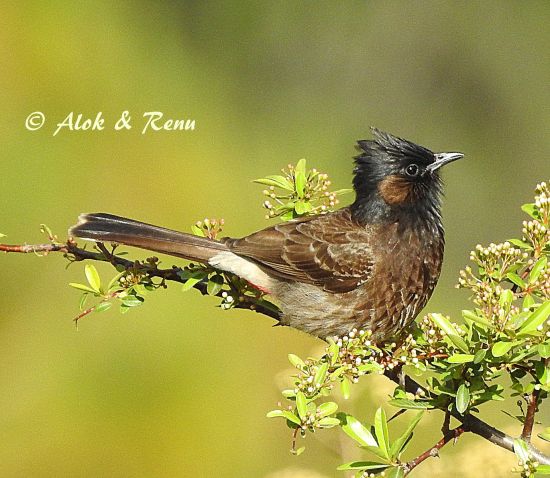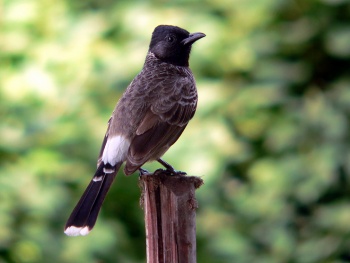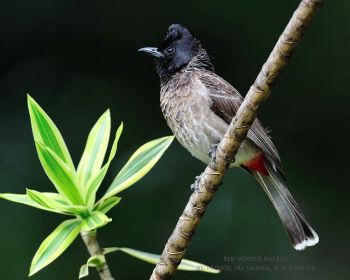
Photo © by Alok Tewari
Dwarahat, Uttarakhand Himalayas, Alt. 5200 ft, India, 8 April 2017
- Pycnonotus cafer
Identification
19–20 cm (7½-8 in)
- Brownish-black upperparts
- White rump
- Brownish-black breast
- White underparts
- Red around the vent
- Black head and small bushy crest
- Long white-tipped tail
Sexes similar; young birds are duller
Distribution
Asia: found in India, Nepal, Sri Lanka, Myanmar and south-western China.
They have been introduced to many areas including Fiji, Hawaii, Texas, Bahrain, Argentina, Samoa,and Tonga. They are also commonly seen in urban parts of Dubai, the United Arab Emirates.
Taxonomy
Subspecies
There are 8 subspecies[1]:
- P. c. intermedius: Himalayas (western Pakistan to western Uttar Pradesh)
- P. c. humayuni: Pakistan (Salt Range) and north-western India
- P. c. bengalensis: central and eastern Himalayas, the Gangetic Plain, and Bangladesh
- P. c. wetmorei: North-eastern peninsula India
- P. c. cafer: peninsular India
- P. c. haemorrhousus: Sri Lanka
- P. c. stanfordi: Northern Burma to extreme south-western China (western Yunnan)
- P. c. melanchimus: South-central Burma (Mandalay to Rangoon)
Habitat
Scrub, open dry deciduous woodland, plains and cultivated land, orchards and gardens.
Behaviour
Breeding
They builds their nest in a bush; the clutch consists of 2-3 eggs.
Diet
The diet includes fruit, buds, nectar, insects and invertebrates.
Vocalisation
A very noisy species
Recording © by Alok Tewari
Janakpuri, Delhi, India, Sep.-2016
Call recorded in an urban garden, 7.15 am.
Recording © by Alok Tewari
Janakpuri, Delhi, India, 22 April 2024, 5.25 am
Summer song recorded before day-break, at 5.25 am; two individuals singing, one close and other at some distance/ three different calls of male Asian Koels are also heard.
References
- Clements, J. F., T. S. Schulenberg, M. J. Iliff, S. M. Billerman, T. A. Fredericks, J. A. Gerbracht, D. Lepage, B. L. Sullivan, and C. L. Wood. 2021. The eBird/Clements checklist of Birds of the World: v2021. Downloaded from https://www.birds.cornell.edu/clementschecklist/download/
- Handbook of the Birds of the World Alive (retrieved July 2015)
Recommended Citation
- BirdForum Opus contributors. (2025) Red-vented Bulbul. In: BirdForum, the forum for wild birds and birding. Retrieved 25 April 2025 from https://www.birdforum.net/opus/Red-vented_Bulbul
External Links
GSearch checked for 2020 platform.





